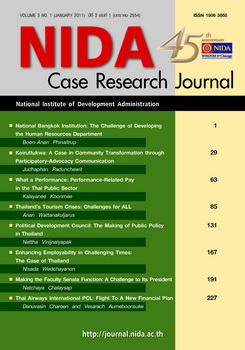Making the Faculty Senate Function: A Challenge to Its President
Keywords:
Decision-making, Participation, Incentives, ManagementAbstract
In mid-2010, several months into the first year of his three-year term of office as president of the nearly moribund Faculty Senate of the National Institute of Development Administration (NIDA), Associate Professor Taweesak Sutakavatin found himself at a loss to know what to do to revitalize the organization. The veteran lecturer in NIDA’s School of Public Administration and former Vice President for Planning had assumed office with great expectations and plans for building the Faculty Senate (“Senate”) into a vibrant and effective voice and representative of the faculty in the affairs of the university. At the time of the landslide faculty vote that propelled him into the position, Prof. Taweesak had deemed it a distinct honor to be accorded the privilege of continuing to make contributions to the advancement of the institution, albeit in a decidedly different role than his erstwhile service as the university’s senior planning executive. He had been convinced that his administrative experience and expertise would stand him good stead in his new role as president of the Senate.Now, after five months of grappling with problems that ran the gamut (from poor meeting attendance and limited cooperation by Faculty Senate committee members to continuing disinterest and non-involvement by members of the faculty at large to Senate budgetary and staffing constraints and so on), Prof. Taweesak’s initial “delight” in having been elected to the post had largely been replaced by growing concern about his prospects of making the Senate function at all. He knew well that unless he could discover ways in which to gain the commitment and teamwork from Senate committee members and the faculty as a whole and overcome the faculty’s disinterest, apathy and cynicism, all of his earlier hopes and plans for the Senate would come to naught.
Unique among cases of its genre, the case tracks the actual investigatory process pursued by the newly Senate president when, at the outset of his term of office, he had set about learning as much as he could concerning the Faculty Senate. Thus, the case begins with information concerning the genesis of faculty senates at Thai universities, as well as what little of the founding and history of NIDA Faculty Senate as could found or pieced together (Prof. Taweesak learned early that the Faculty Senate Office was completely devoid of organizational documents, including any chronicling the Senate’s history). An account of the Senate’s mission and recent programmatic activities is then presented, followed by a discussion of a plethora of problems and issues that had been serious obstacles to the efficient and effective functioning of organization. Previous attempts and current thinking concerning resolution of some of these obstacles are then elaborated. The case then presents the “voices” (i.e., views, thoughts, suggestions, and the like) of several different groups of “stakeholders” in the functioning of the Senate: past and present presidents and vice Presidents of the Faculty Senate, past and present Faculty Senate committee members, and faculty members from different NIDA schools.
The case ends with Associate Professor Taweesak’s vocalized determination to not give up hope, but to persevere. But, in so doing, he had to come up with answers to a number of questions, among which were: “What activities should be included in his action plan?”; “How could he get the Senate committee members and lecturers in general to participate in the Senate activities?”; “How could he deal with inadequate personnel and Senate financial resources?”; and, “How could he make the Faculty Senate more important in the eyes of the faculty in general?”





